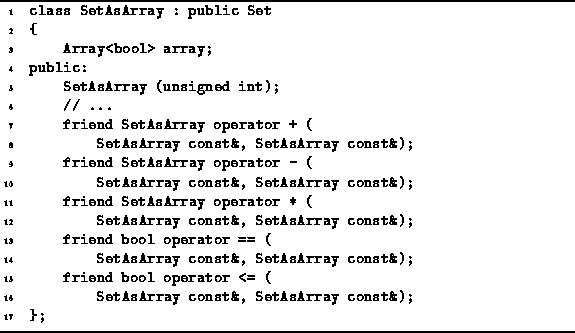In this section we consider finite sets over a finite universe.
Specifically, the universe we consider is ![]() ,
the set of integers in the range from zero to N-1,
for some fixed and relatively small value of N.
,
the set of integers in the range from zero to N-1,
for some fixed and relatively small value of N.
Let ![]() be the universe.
Every set which we wish to represent is a subset of U.
The set of all subsets of U is called the power set
of U and is written
be the universe.
Every set which we wish to represent is a subset of U.
The set of all subsets of U is called the power set
of U and is written ![]() .
Thus, the sets which we wish to represent are the elements of
.
Thus, the sets which we wish to represent are the elements of ![]() .
The number of elements in the set U, written |U|, is N.
Similarly,
.
The number of elements in the set U, written |U|, is N.
Similarly, ![]() .
This observation should be obvious:
For each element of the universal set U there are only two possibilities:
Either it is, or it is not,
a member of the given set.
.
This observation should be obvious:
For each element of the universal set U there are only two possibilities:
Either it is, or it is not,
a member of the given set.
This suggests a relatively straightforward
representation of the elements of ![]() --an array of Boolean values, one for each element of the universal set.
By using array subscripts in U,
we can represent the set implicitly.
I.e., i is a member of the set if the
--an array of Boolean values, one for each element of the universal set.
By using array subscripts in U,
we can represent the set implicitly.
I.e., i is a member of the set if the ![]() array element is true.
array element is true.
Program ![]() declares the class SetAsArray.
This class uses an array of length
declares the class SetAsArray.
This class uses an array of length ![]() to represent the elements of
to represent the elements of ![]() where
where ![]() .
A SetAsArray is a Set.
Therefore, it supports the basic operations of searchable containers
including Insert, IsMember, and Withdraw.
.
A SetAsArray is a Set.
Therefore, it supports the basic operations of searchable containers
including Insert, IsMember, and Withdraw.

Program: SetAsArray Class Definition
In addition, Program ![]() overloads the operators
+, *, -, ==, and <=.
The first three operators correspond to
set union, set intersection, and set difference (respectively).
The last two are used to compare two sets and
to determine whether one set is a subset of another.
overloads the operators
+, *, -, ==, and <=.
The first three operators correspond to
set union, set intersection, and set difference (respectively).
The last two are used to compare two sets and
to determine whether one set is a subset of another.